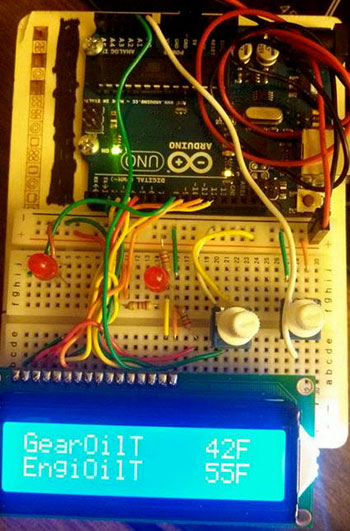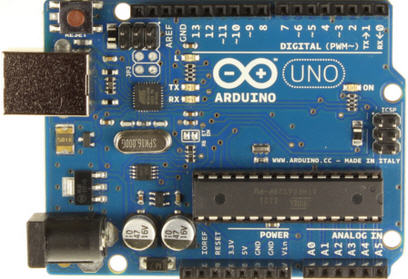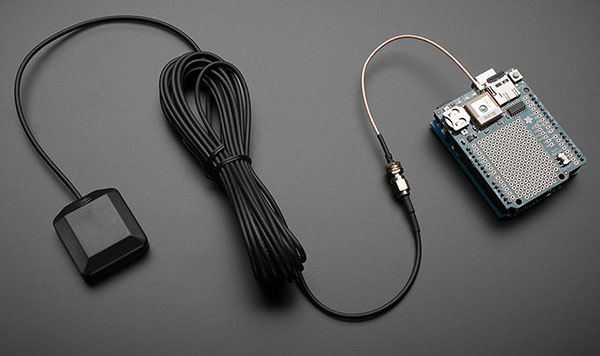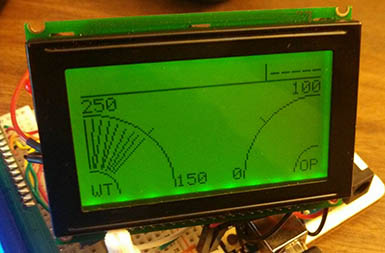Dash Display for the Clemson BAJA SAE
by Victor Gallas, Clemson Automotive Engineering Student
- Basic Description
-
 The Baja SAE is a collegiate design competition sponsored by the Society of Automotive Engineers in which teams from universities around the world compete in an off-road challenge. Student members work together in order to design, build, test, promote, and race a rugged, single seat, off-road vehicle. Its intended market is the non-professional weekend off-road enthusiast. Accordingly, the vehicle must be safe, attractive, easily transported and maintained, and fun to drive. The Baja SAE is a collegiate design competition sponsored by the Society of Automotive Engineers in which teams from universities around the world compete in an off-road challenge. Student members work together in order to design, build, test, promote, and race a rugged, single seat, off-road vehicle. Its intended market is the non-professional weekend off-road enthusiast. Accordingly, the vehicle must be safe, attractive, easily transported and maintained, and fun to drive.
The team identified a need to have a display to show the temperatures of the gearbox and engine oil temperatures as these are two areas of the vehicle with extreme use during the long endurance races that are normally up to 4 hours long. The gearbox on the car is designed by the team and oil temperatures are a key indicator of bearing wear and damage due to excessive loading.
The initial iteration of the display consists on just displaying the analog temperature signals fed from two analog temp sensors onto the display unit. Two additional LED's provide additional warning to the drivers under extreme conditions, as it will flash once the temperature goes above a predetermined set point. This was added to provide additional warning to the drivers after the team identified that a display alone would most likely not capture the attention of the drivers while driving the races.
A demo video of the pro type setup working with potentiometers used as surrogates to simulate an analog temperature input is shown on this link.
- System Components
Electronic components
All of the components chosen for this project where all items available in the Arduino introduction kit utilized as part of the class assignments which also includes the serial matrix display dash. The additional items, not shown here, are the analog temperature sensors that the BAJA team acquired and installed onto their vehicle to be later integrated to the dashboard once it is installed onto the vehicle.

Dash Housing
The dash display needs to be enclosed in a water-tight housing that can endure water, mud and shocks conditions in order to preserve and maintain the electronic components inside. An initial design iteration of the housing being considered is shown below. This housing has additional warning LED's and possibly incorporate a LED tachometer light bar. The housing was designed with a removable rear lid and is being planned to be 3D printed at the Clemson Environmental Technologies Lab at the main campus in Clemson, SC.

Future Development
Two main items are desired to be added to the display in the future iterations. The first needed item that the team expressed interested in developing is to add a data logger setup. An Arduino data logging shield with GPS is now available by Adafruit which can be incorporated to the Arduino Uno board easily and used for recording the data from the signals of the sensors utilized together with a GPS to track the car vehicle. This is a low cost data logging solution that the team could utilize in order to improve their capabilities by understanding what the car is actually doing at all times while on track. This simple solution will be a cost effective solution for the team because it also provides additional points at their competition for developing an in-house solution.

Upgraded Screen
The second item that is being desired to be upgraded is the screen. The initial screen utilized was from the starter kit. The team has shown interest in developing a larger screen for the purpose of displaying more sensors. The larger LCD screen can be used to display low resolution graphics in a larger, more easier to read display. This display is a serial enabled display offered by Sparkfun Electronics. The picture below demonstrates an initial attempt at creating a working graphic display, however some difficulties were encountered when attempting to submit serial data to the screen to display and thus the original screen available on the started kit was utilized. Further work on the graphic display will continue.

- Sensors
- Fluid Temperature Sensor
- Manufacturers
- Arduino
- For More Information
- [1] TKThermistor, Tinkerkit.com.
|

